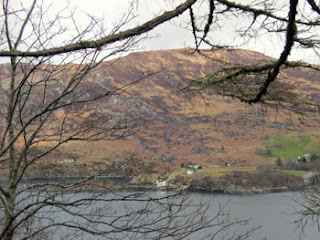I'm an island person, and I love wild places. It took me three days, though, to fall in love with Skye. The weather's been harsh, admittedly, and the land is still gripped by winter, but the view from our cottage of rusting cars, wind turbines, and conifer plantations or clear-felled low scrubby hillsides, with the head of the sealoch visible but not accessible, haven't helped. Elsewhere there is the drama of character-full peaks and crags – some of the wildest climbing in Europe, I'm told, including twenty munros – and the sea, but not here.
Then, yesterday, hooray – the Waternish peninsula. Above you can see the curve of bay and the little lagoon of Ardmore, or Aird Mhor; below, in front of the ruins, if you look closely, are a flock of Canada geese and some cream-white Highland cattle browsing on kelp. The famed cattle here were swum across to the mainland for selling as early as the 1500s; some were even driven (clearly, on foot; a journey of – what, 5-600 miles?) to Smithfield market in London.
An t-Eilean Sgitheanach or Eilean a' Cheò (the latter means the 'Isle of Mists') are the Gaelic names for Skye (there is still a strong Gaelic-speaking population, and some schools are taught all the subjects in Gaelic. The island has a School of Gaelic too.) There are settlements here that date back to the Neolithic, and then the later Bronze and Iron Ages, with a couple of Pictish brochs, the double-skinned towers, and some rare Pictish inscribed stones have been found here.
The island's later history, as in many parts of the Hebrides and northwest Scotland, includes a great deal of Norse settlement, seen clearly in names that end in 'nish', or 'ness', which means headland or peninsula. The traditional ruling clan of Skye and much more besides, Clan Macleod, is of Norse descent. Skye has been the scene of many battles and skirmishes; its bloody history played out too in the Highland clearances following on from the Jacobite rebellion.
What makes me feel at home here where I don't around the cottage, apart from the sea (at Waternish you look out to North Uist and Harris, over the Little Minch with its daunting currents and races), is the appearance of the headlands with their successive stepped spills of lava-flow, their clearly-basalt verticals and plateaux, familiar to me from Mull (and of course Staffa). (These fingers of land stretching west into the Atlantic also remind me of Morte Point and Baggy Point on the north Devon coast of my childhood.)
You can see the cut-off edges of the land here in the top photo, and below on the point on the left and perhaps in the little shelf-like islets:
The basalt seam in the Hebrides, that stretches to the Giant's Causeway in Ireland, includes raised beaches. Norman Newton's book Skye describes how these were formed: 'These are evidence of a time when sea-level was higher than it is today... they occur at different levels and date from different times, but all are the result of changes in sea-level caused by the last Ice Age. From 20,000 BCE when the ice began to melt seriously until soon after 8000 BCE when the first Mesolithic hunter-gatherers appeared on the scene there were several variations in sea-level. When the ice first melted, which was a fairly rapid process, sea-level rose, and waves crashed into the land at a higher level, forming cliffs and beaches. However, with the great weight of ice removed from the land – it was over a mile thick – the land actually began to rise. This process, known as "isostatic recovery", eventually had the result of leaving the post-glacial beaches high and dry.'
The geology here is diverse. Much of the rock is volcanic in origin; there are sedimentary layers, such as Torridonian sandstone and oolitic limestone, plus the igneous granite and gabbro amongst others.

One of the most famous stories out of Skye is of course the flight of Bonnie Prince Charlie 'over the sea to Skye'. Near here is a monument to Flora MacDonald, who, at his begging, helped him escape from Benbecula, the isthmus-causeway between North and South Uist, across the perilous Little Minch by dressing him up as her female companion, the supposed Irish housemaid Betty Burke. This was a mindblowingly dangerous thing to do in several ways.
While I understand the Jacobite Cause and the romance of it, returning the throne to a non-Hanoverian, further research suggests, disappointingly, that BPC was a bit of a privileged plonker, dissolute and philandering. What's more, Flora was imprisoned for a while in the Tower of London for her pains, while he escaped. He promised to reward her, but in 40 years he didn't contact her again. A quick google search suggests that Flora's life was a courageous and exciting series of adventures. If anyone knows of a book on her life, fictionalised or otherwise, I'd be glad to know.
It's hard not to notice the sheer scale of the dumped or lost plastic flotsam/jetsam here (jetsam mostly I rather fear). The tidelines are rainbowed with litter. I'm trying to see this as non-detracting; here at least it's broken down into plastic-'shell'sand, sort-of:
Returning to the head of the loch the foreshore offers natural colour:
... and in the little pub, the oldest on Skye, in the village of Stein I hear faintly, over the babble of voices, from Radio 2 that despite our ill-advised (I'm being polite) Minister of Environment's refusal to sign up to a ban, and despite the lobbying from the all-powerful pharmaceutical industry, neonicotinoids, pesticides linked to bee-decline, have now been banned from Europe for two years at least. HOORAY.




































